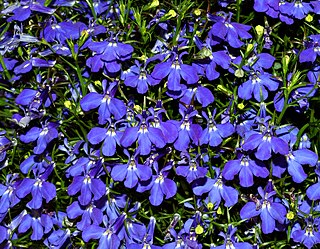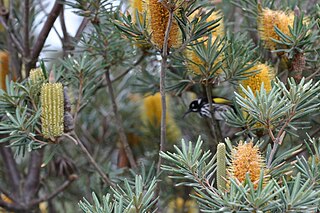Mount Remarkable National Park is a protected area in the Australian state of South Australia located about 238 kilometres (148 mi) north of the state capital of Adelaide and 25 kilometres (16 mi) east of Port Augusta. It is also the name of the highest peak in the park, with a height of 960 metres (3,150 ft).

Lobelia is a genus of flowering plants comprising 415 species, with a subcosmopolitan distribution primarily in tropical to warm temperate regions of the world, a few species extending into cooler temperate regions. They are known generally as lobelias.

Isopogon, commonly known as conesticks, conebushes or coneflowers, is a genus of about forty species of flowering plants in the family Proteaceae, and are endemic to Australia. They are shrubs with rigid leaves, bisexual flowers in a dense spike or "cone" and the fruit is a small, hairy nut.

Banksia verticillata, commonly known as granite banksia or Albany banksia, is a species of shrub or (rarely) tree of the genus Banksia in the family Proteaceae. It is native to the southwest of Western Australia and can reach up to 3 m (10 ft) in height. It can grow taller to 5 m (16 ft) in sheltered areas, and much smaller in more exposed areas. This species has elliptic green leaves and large, bright golden yellow inflorescences or flower spikes, appearing in summer and autumn. The New Holland honeyeater is the most prominent pollinator, although several other species of honeyeater, as well as bees, visit the flower spikes.

Banksia tenuis is a species of shrub that is endemic to the southwest of Western Australia. It has pinnatifid, serrated or smooth-edges leaves, golden brown and cream-coloured flowers in heads of about fifty-five and glabrous, egg-shaped follicles.

Dampiera is a genus of about 70 species of flowering plants in the family Goodeniaceae, all of which are endemic to Australia. Plants in the genus Dampiera are subshrubs or herbs with sessile leaves, flowers with five small sepals and blue, violet or pink, rarely white, two-lipped flowers.

Petrophile is a genus of evergreen shrubs, in the family Proteaceae. The genus is endemic to Australia. Commonly known as conebushes, they typically have prickly, divided foliage and produce prominently-displayed pink, yellow or cream flowers followed by grey, conical fruits.

Pratia is a formerly recognized genus of flowering plants in the family Campanulaceae, native to Asia, Australia and New Zealand. Along with other genera, such as Hypsela and Isotoma, it is now included in Lobelia.

Grevillea parviflora, commonly known as small-flower grevillea, is a species of flowering plant in the family Proteaceae and is endemic to the Sydney region of eastern New South Wales. It is a low, dense, spreading to erect shrub with more or less linear leaves and white flowers with a red style that sometimes turns red as it ages.

Lobelia heterophylla is a blue to purple flowered herb found in Southern Australia. The specific epithet refers to the variety of leaf forms found on individual plants. The species was first described by Jacques Labillardière in his seminal work on Australian flora, Novae Hollandiae Plantarum Specimen. L. heterophylla has a wide distribution, due to its ability to inhabit a variety of soil types. The habit of the herbaceous plant is erect, up to 0.6 metres, with flowers appearing from August or October to December, or January to February. The flower whorl is deeply cleft, its colour range of blue, scarlet or purple is well known and it is considered to be a desirable specimen for use in gardens. The plant is commonly referred to as wing-seeded lobelia and Australian blue creeper. The species was featured and illustrated by Joseph Paxton in 1838.

Agastachys odorata, commonly known as the white waratah or fragrant candlebush, is the sole member of the genus Agastachys in the protea family. It is an evergreen shrub to small tree and is endemic to the heaths and button grass sedgelands of western Tasmania.
Hibbertia marginata, commonly known as bordered guinea flower, is a species of flowering plant in the family Dilleniaceae and is endemic to the North Coast of New South Wales. It is a spreading shrub with hairy young branches, oblong to lance-shaped leaves and yellow flowers with thirty to forty stamens and many staminodes arranged around three hairy carpels.

Verticordia densiflora, commonly known as compacted featherflower, is a flowering plant in the myrtle family, Myrtaceae and is endemic to the south-west of Western Australia. It is a shrub with small leaves, usually small pink and white flowers and which is widespread in the south-west of the state. It is a variable species and in his 1991 paper, Alex George formally described five varieties.
Verticordia densiflora var. pedunculata, commonly known as long-stalked featherflower, is a flowering plant in the myrtle family, Myrtaceae and is endemic to the south-west of Western Australia. It is a shrub with small leaves and mauve-pink flowers which fade to white. It is one of five varieties of the species Verticordia densiflora and is distinguished from the others by its much longer flower stalks.

Isotoma fluviatilis, the swamp isotome or blue star creeper, is a small herbaceous perennial plant in the family Campanulaceae, native to Australia.

Lobelia anceps, commonly known as angled lobelia, is a small herbaceous plant in the family Campanulaceae it grows in several states of Australia, New Zealand, South America and South Africa. It is a small, perennial herb with blue to purple flowers.
Lobelia dioica is a small herbaceous plant in the family Campanulaceae native to Western Australia.

Lobelia douglasiana is a flowering plant in the family Campanulaceae and is endemic to northern Australia. It is a small, spreading herb with blue and white flowers.

Diuris pedunculata, commonly known as the small snake orchid, is a species of orchid which is endemic to New South Wales. It usually has two leaves at its base and one or two yellow and orange flowers with purple markings. It originally occurred in scattered populations between Tenterfield and the Hawkesbury River but because of habitat loss is now only known from the New England Tableland.

Hibbertia hibbertioides is a species of flowering plant in the family Dilleniaceae and is endemic to near-coastal areas of south-western Western Australia. It is a small, prostrate or sprawling shrub with crowded, linear cylindrical leaves and yellow flowers with usually eleven stamens arranged in groups around three carpels.
















